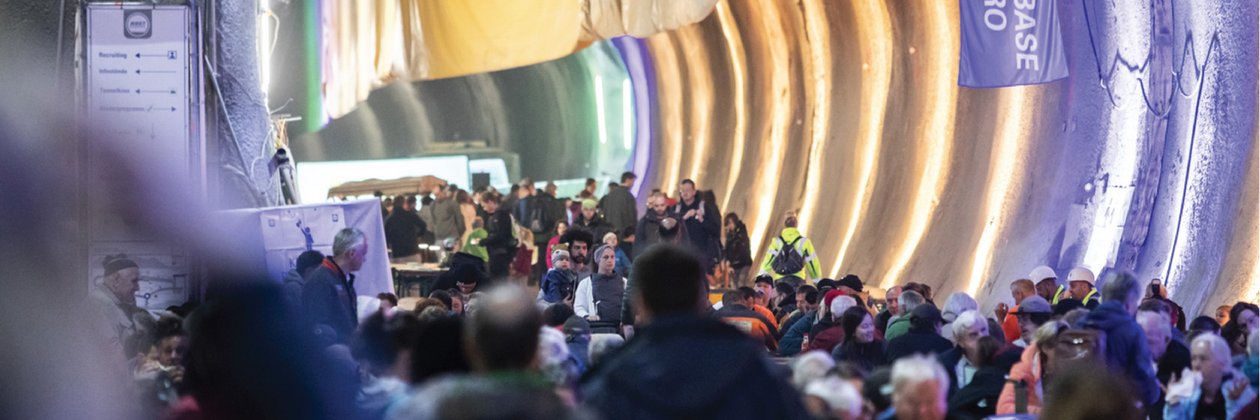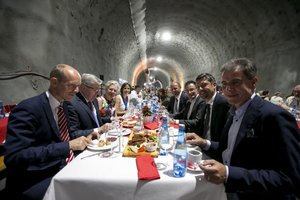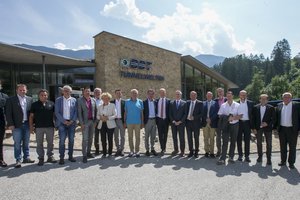(Steinach am Brenner) Das Baulos „Pfons-Brenner“ ist der größte und zugleich der südlichste Bauabschnitt des Brenner Basistunnels auf österreichischem Projektgebiet. Am 1. Juli 2019 wurde im Beisein von EU-Koordinator Pat Cox, seiner Frau Kathleen Cox als Tunnelpatin, DG Move Direktor Herald Ruijters, Peter Endrizzi von der Brenner Corridor Platform (BCP), PORR CEO Karl-Heinz Strauss sowie BBT SE Vorstand Konrad Bergmeister, die östliche Haupttunnelröhre Richtung Süden angeschlagen.
Der Anschlag erfolgte durch die Sprengung, die von „Tunnelpatin“ Kathleen Cox ausgelöst wurde. Sie sprach von einer „großen Ehre und einem großen Privileg“. Die zuvor vom Pfarrer der Gemeinde Steinach, Cons. Albert Moser, gesegnete Heiligenfigur der Heiligen Barbara „möge über allen wachen“ betonte sie, ehe das bronzene Tunnel-Patin-Schild unter Applaus der geladenen Gäste enthüllt wurde.
Im Rahmen des Festaktes begrüßte Konrad Bergmeister als Bauherr: Südtirols LH-Stv. Daniel Alfreider und Tirols LH-Stv. Josef Geisler, die Aufsichtsratsmitglieder der BBT SE, Hubert Hager, Herbert Kasser und Martin Ausserdorfer, zugleich Direktor der BBT-Beobachtungsstelle zum Bau des BBT. Die Präsidentin der BBT-Beobachtungsstelle, Maria Anna Gasser Fink, auch Bürgermeisterin der Gemeinde Klausen. Den Aufsichtsratsvorsitzenden der ÖBB-Holding, Gilbert Trattner sowie zahlreiche Bürgermeisterinnen und Bürgermeister aus Nord- und Südtirol, deren Gemeinden entlang des BBT-Projektgebietes liegen.
Ebenso anwesend waren: Vertreter von Feuerwehren, Rettung und Polizei, Behörden und Projektpartnern, Ingenieurbüros und Zulieferern. Zur Festveranstaltung kamen auch zahlreiche Anrainer von Steinach und die ehemaligen Tunnelpatinnen Maya Tilg und Karin Grissemann. Auch für die Mitarbeiter der ARGE H51 und der BBT SE war der Tunnelanschlag ein besonderer Festtag.
Die Feierlichkeiten fanden im Rahmen des Bürgermeistertreffens mit dem Europäischen Koordinator für den Skandinavien-Mittelmeerkorridor statt, zu dem die EU sämtliche Ortsvorsteher entlang des Projektgebietes geladen hatte.
Der Brenner Basistunnel gilt als Nummer 1-Projekt des transeuropäischen Verkehrsnetzes (TEN). Das Treffen beschäftigt sich mit dem TEN-Transport Korridor und hat den gemeinsamen Austausch mit den Anrainern entlang des Projekts BBT zum Ziel. Der Brenner Basistunnel als größtes europäisches Infrastrukturprojekt im Herzen dieses Korridors wird die beiden Länder Österreich/Italien abseits der Staatsgrenze nachhaltig verbinden und nach Fertigstellung wesentlich zur Entlastung der Transitproblematik beitragen.
„Mit dem heutigen Anschlag beginnen wir mit dem Abschnitt zur Unterquerung des Brenners“, zeigte sich BBT SE Vorstand Konrad Bergmeister sehr zufrieden: „Es ist das Herzstück des transeuropäischen Korridors. Der Brenner Basistunnel alleine genügt aber nicht, wir benötigen vor allem die Terminals, Anbindungen und die Zulaufstrecken, um den Schwerverkehr auf die Schiene zu verlagern.“
Der CEO der PORR, Karl-Heinz Strauss, sieht im Bau des Brenner Basistunnels eine hohe Wertschöpfung für die Region: „Es werden viele lokale Unternehmen beschäftigt, der Tunnelbau gehört zu den Top-Sparten innerhalb der Bauindustrie.“
Herald Ruijters, Direktor Europäisches Mobilitätsnetzwerk: „Europa rückt durch den Bau des BBT immer mehr zusammen. Ich danke den Bürgermeistern der Projektgemeinden, den Landeshauptmännern von Nord- und Südtirol und den beiden Vorständen der BBT SE, Konrad Bergmeister und Raffaele Zurlo, für das Engagement und die jahrelange Unterstützung des Projektes.“ Die EU stehe zu 100 Prozent hinter dem BBT, „wir wissen wohin und warum“.
Für EU-Koordinator Pat Cox wird mit diesem Bauabschnitt der europäische Kontinent verbunden: „Es ist ein Meilenstein und großer Fortschritt dieses ambitionierten, europäischen Infrastrukturprojektes“.
Infrastruktur wird nur gebaut, um mehr Lebensqualität zu erreichen“, bekräftigt Südtirols Landesrat Daniel Alfreider. „Für unseren sensiblen Lebensraum in den Alpen und den Menschen, die darin leben, ist dieses Infrastrukturprojekt sehr wichtig.“ Dieser Tunnelbau sei ein Projekt der europäischen Integration und beginne bereits bei der Arbeit, an der zwei Nationen, Österreich und Italien, beteiligt sind.
Tirols Landeshauptmannstellvertreter Josef Geisler erklärte, dass mit dem Brenner Basistunnel, die „Mobilität der Zukunft“ beginne.
Daten zum Baulos Pfons-Brenner
Im Herbst 2018 begannen die Arbeiten beim Baulos Pfons-Brenner, welches ein Auftragsvolumen von 966 Millionen Euro aufweist. Voraussichtlich bis Anfang 2025 sind dort 52 Tunnelkilometer, davon 37 km Haupttunnelröhren, rund 9 km Erkundungsstollen sowie eine Nothaltestelle und eine Überleitstelle bei St. Jodok am Brenner voranzutreiben.
Die Arbeitsgemeinschaft, bestehend aus den österreichischen Baukonzernen PORR Bau GmbH und G. Hinteregger & Söhne Baugesellschaft m.b.H. und den italienischen Baukonzernen Società Italiana per Condotte d’Acqua S.p.A. und Itinera S.p.A. ist für die bauliche Umsetzung zuständig. Etwa 32 km Haupttunnel werden mittels Tunnelbohrmaschinen (TBM) maschinell aufgefahren. Die restlichen 5 km werden im bergmännischen Sprengvortrieb ausgeörtert. Derzeit arbeitet man an 4 Vortrieben mit Sprengungen, maximal 7 Vortriebe wird es geben. In Abständen von 333 m verbinden insgesamt 55 Stollen, sogenannte “Querschläge”, die beiden Haupttunnel. Die Querschläge erfüllen sowohl eine logistische als auch eine Sicherheitsfunktion. Dieses Konzept entspricht höchsten Sicherheitsstandards im Tunnelbau.







